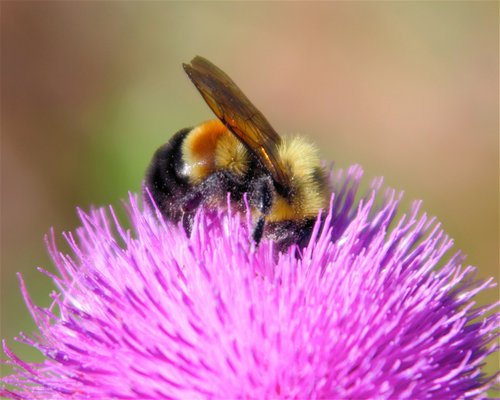
It’s mid-January as I write this, and we’ve just come out of a brutal cold spell into two warm days in a row. The temperature is flirting with 50 degrees, and one of my hives is aflutter with activity. Bees are coming and going, savoring the warm air and taking a few minutes to relieve themselves over my truck, which seems to be one of their very favorite pastimes.The other hive sits there in a lump, no activity to be seen. I really want to pop the hood and see what’s going on in there. An accomplished pessimist, I assume the bees are all dead. I have stalked around the hive, put my ear against the wall, and knocked on the front door to try and raise a sentry. Nothing.
Those of you who are seasoned readers of this column may remember a similar situation two years ago. It was March. February had been brutally cold and snowy. I was afraid the girls in one hive would run out of food before it warmed up enough for them to start foraging. It was a little over 50 degrees out—way colder than the 93 degrees they keep it inside. But I popped the top off, just for a minute, to give them some food. When the weather warmed up a couple of weeks later, the other hive burst joyfully into spring. The hive I fed did not. On inspection it became clear that the girls were not even close to being out of food. I did, however, manage to give the hive a fatal chill by opening the hive too early.
So I am giving myself a stern talking-to and stepping away. It’s either alive or dead, and I’ll know soon enough. For now, let’s distract ourselves with a look at some of my girls’ close relations, and how they’re faring in the bigger picture.
You may have read earlier this month that the rusty-patched bumblebee has been listed as an endangered species by the U.S. Fish and Wildlife Service. Once widespread across the Midwest and Northeast, Bombus affinis has seen its population plummet by 90 percent in the past two decades, the victim of pesticides (especially neonicotinoids), disease, habitat loss and climate change. As of this writing, these once ubiquitous flying fuzzballs are scarce as hen’s teeth.
But an official listing under the Endangered Species Act is actually a good thing, relatively speaking. It gives the rusty-patched bumblebee (let’s just call it Rusty from now on) some regulatory clout. Activities known to harm endangered species can be restricted, and the government is required to prepare a recovery plan for the species.
This is the first time a wild bee of any kind has been added to the endangered species list in the lower 48 states. The honeybee, while widely acknowledged to be in serious trouble, is not native to North America, and so not eligible for protected status.
Rusty’s status is good news for the rest of the pollinators that share his environment, because actions taken to protect this species will benefit the thousands of other varieties of pollinators—bees, butterflies, wasps and birds—that inhabit the same territory.
In our own backyards, you’re most likely to see the Bombus impatiens, the common eastern bumblebee, the American bumblebee (Bombus pennsylvanicus) or the Golden Northern Bumblebee (Bombus fervidus). These are all classic yellow and black, large and fuzzy. The American is a bit larger than the others, with a nice temperament that makes her suitable for petting, especially when she’s got her pollen pockets happily loaded up and is moving slow.
But even if you’re not the kind of crazy that makes petting bugs seem like a good idea, you probably enjoy watching the bumbles as they make their way from flower to flower on a warm summer day. They have somehow attained the ability to amble while flying—not an easy feat. There is an air about them that’s non-threatening and amiable, even though they are, like most bees, armed with venomous stingers. But really, when’s the last time you heard of anybody being stung by a bumble?
Most critically, bumblebees are hugely important pollinators. Like their honeybee cousins, they cover a wide territory in their travels. Their especially furry coats pick up even more pollen than the coats of honeybees, increasing their effectiveness as pollinators.
Bumbles are also early to rise. Many of them leave their ground nests very early in the spring and forage until late fall, ensuring that early and late-blooming flowers aren’t left out of the pollination party.
Many people tell me that they’re just not seeing bumblebees in the numbers they used to on the East End. Like Rusty and the honeybees, all the bumbles are struggling with loss of habitat, toxic pesticide exposure and bee plagues like varroa mites.
It’s not easy being a bee these days. But with Rusty making it onto the endangered species list, we can hope that all of our flying friends stand a better chance of thriving in the future. As for my own girls, all I can do for now is hope the quiet hive is having a good long rest and will be out and about when warm weather returns.